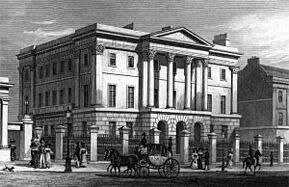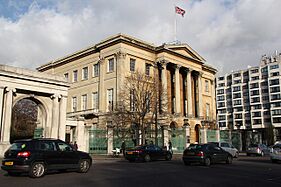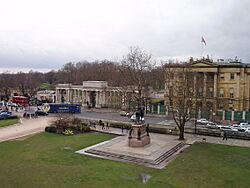Apsley House facts for kids
Quick facts for kids Apsley House |
|
|---|---|
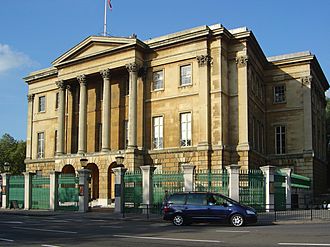
The front of Apsley House in 2005
|
|
| General information | |
| Architectural style | Neo-classical |
| Location | 149 Piccadilly London, W1 |
| Country | United Kingdom |
| Coordinates | 51°30′13″N 0°09′06″W / 51.5035°N 0.1517°W |
| Client | |
| Design and construction | |
| Architect |
|
|
Listed Building – Grade I
|
|
| Reference #: | 1226873 |
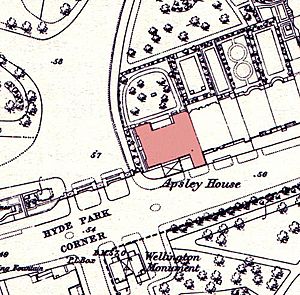
Apsley House is a famous old house in London. It was once the city home of the Dukes of Wellington. You can find it standing alone at Hyde Park Corner, right next to Hyde Park.
This beautiful building is sometimes called the Wellington Museum. It is open to the public as a museum and art gallery. Here, you can see many paintings and items that belonged to the first Duke of Wellington.
The house is also known as Number One, London. This nickname came about because it was the first grand house people saw when they arrived in London from the countryside. Today, it is a special Grade I listed building, meaning it is very important and protected.
Contents
History of Apsley House
Building the First House
Apsley House was built on land that used to be a royal hunting lodge. Later, a tavern called the Hercules Pillars stood here. Imagine, a famous writer named Henry Fielding even mentioned this tavern in his book, The History of Tom Jones, a Foundling!
The house you see today was designed by a famous architect named Robert Adam. He built it between 1771 and 1778 for Lord Apsley. Lord Apsley was a very important judge, and the house was named after him.
How the Duke of Wellington Acquired the House
In 1807, Richard Wellesley bought the house. He was the older brother of Arthur Wellesley. But Richard faced money problems.
So, in 1817, he sold the house to his younger brother, Arthur. By then, Arthur was already famous as the Duke of Wellington. He needed a grand home in London for his new career in politics.
Changes by the Duke of Wellington
The Duke of Wellington hired an architect named Benjamin Dean Wyatt to make big changes to the house. The first changes started in 1819. A new three-storey part was added to the house. This new section included a fancy dining room and bedrooms.
The outside of the house, which was originally red brick, was covered in a special stone called Bath stone. A grand entrance with columns was also added. These changes made Apsley House even more impressive.
The Waterloo Gallery
One of the most important additions was the "Waterloo Gallery." This long room is named after the Duke's famous victory over Napoleon at the Battle of Waterloo in 1815.
Every year, the Duke held a special dinner called the Waterloo Banquet in this gallery. It was a way to remember his great victory. You can still see a large statue of the Duke on his horse across the road from the house. This statue was made from guns captured during the battle!
Apsley House as a Museum
In 1947, Gerald Wellesley, 7th Duke of Wellington, gave the house and many of its treasures to the nation. This meant that the public could now visit and enjoy this historic place.
The house was updated with electricity and opened as a museum in 1952. Today, English Heritage looks after Apsley House. The current Duke of Wellington still lives in a private part of the house. This means the family continues to have a connection to this amazing piece of history.
Gallery
-
The statue of the Duke of Wellington facing Apsley House. Hyde Park Corner to the left.
-
Portrait of the Duke of Wellington, by Thomas Lawrence (c. 1815–16)
-
Antonio Canova's statue of Napoleon as Mars the Peacemaker (1806)
-
Diego Velázquez's Waterseller of Seville (1623)
See also
 In Spanish: Apsley House para niños
In Spanish: Apsley House para niños
- List of monuments to Arthur Wellesley, 1st Duke of Wellington
- Stratfield Saye House – the country home of the Dukes of Wellington
- Walmer Castle – another home of the 1st Duke
- Waterloo ceremony


